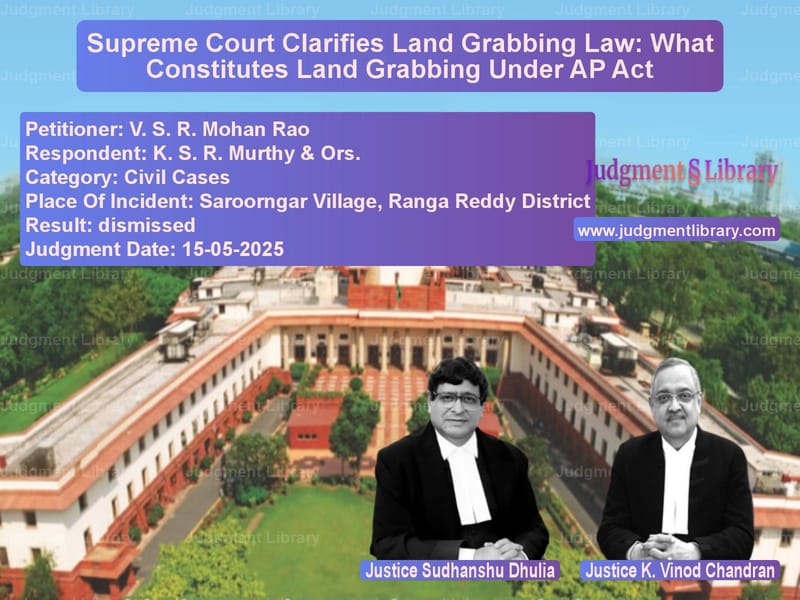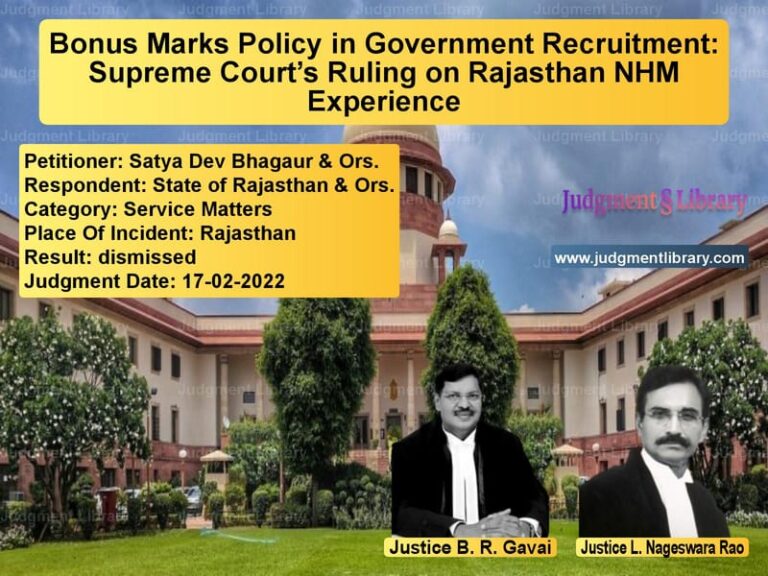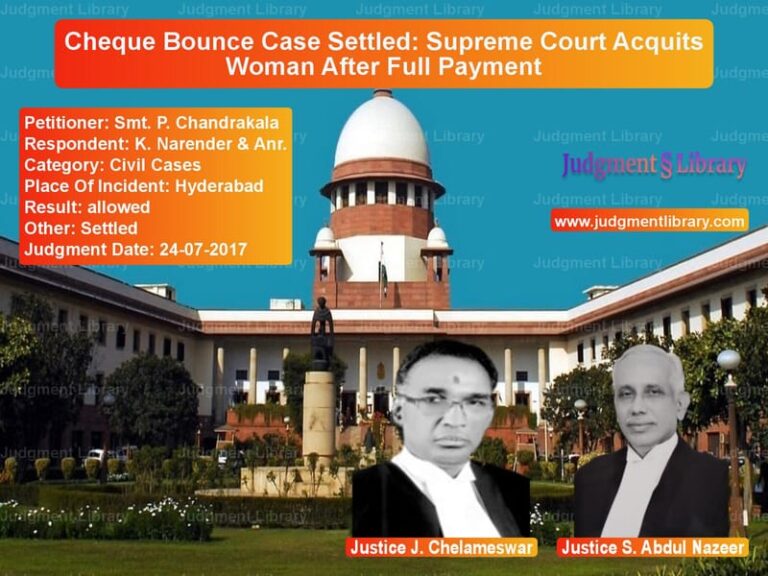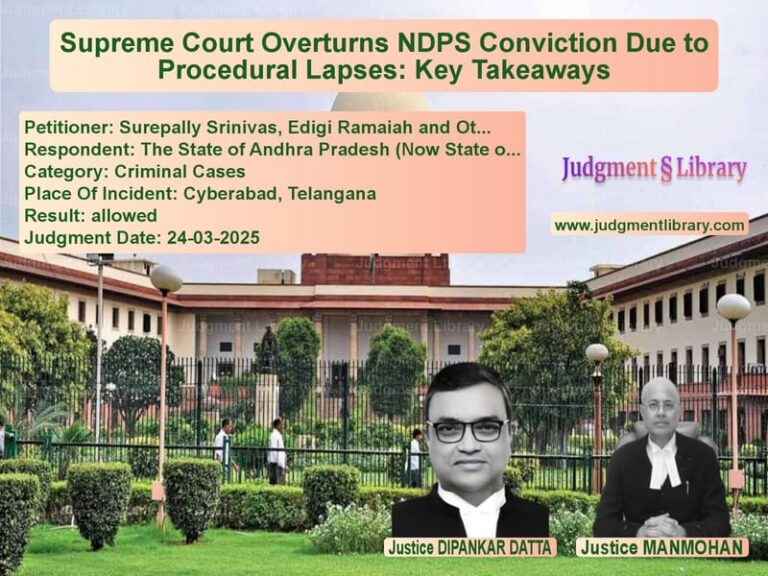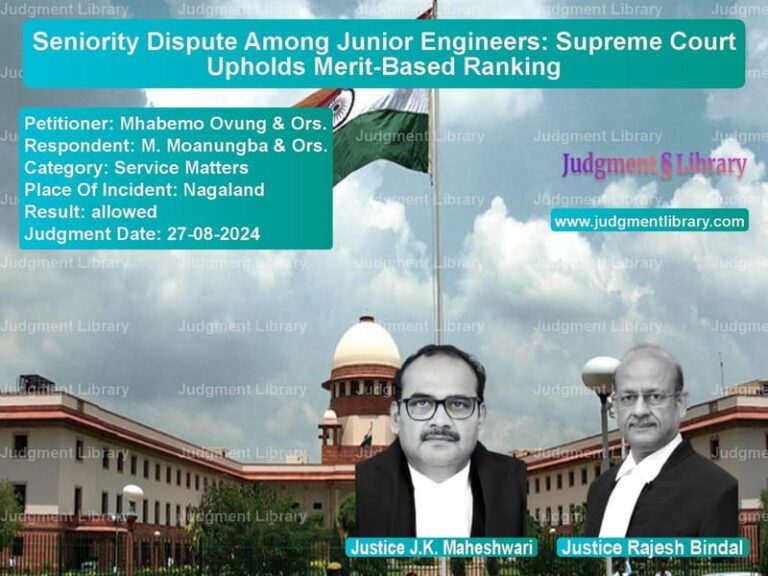Supreme Court Clarifies Land Grabbing Law: What Constitutes Land Grabbing Under AP Act
In a significant ruling that clarifies the scope and application of anti-land grabbing legislation, the Supreme Court of India recently delivered a judgment that distinguishes between simple trespass and land grabbing under the Andhra Pradesh Land Grabbing (Prohibition) Act, 1982. The case of V.S.R. Mohan Rao versus K.S.R. Murthy & Others, decided on May 15, 2025, provides crucial guidance on when possession of land crosses the line from mere trespass to land grabbing, attracting the stringent provisions of special legislation designed to combat this social evil.
The legal dispute centered around 252 square yards of land in Saroornagar Village, Ranga Reddy District, which the appellant, V.S.R. Mohan Rao, had purchased through a registered sale deed dated March 27, 1997. He had constructed a double-storied building on the property and had been residing there since his purchase. The respondents, representing the original applicant before the Special Court, claimed ownership of the land through a registered sale deed dated January 1, 1965, covering 555 square yards in survey number 9. They alleged that the appellant had illegally occupied a portion of their property, constituting land grabbing under the special legislation.
Representing the appellant, Senior Counsel Smt. Madhvi Diwan argued vigorously that the provisions of the Land Grabbing Act could not have been invoked against her client. She contended that “The appellant, if at all, was a simple trespasser, who had bonafide purchased the property by way of a registered sale deed dated 27.03.1997 and had been in residence in a double storied building constructed on it.” She emphasized that the appellant had purchased the land from vendors who traced their title to a Housing Society, and if there were any doubts about his title, it had been perfected by his predecessors through adverse possession, given that a two-storied building had existed on the land for many years.
The learned Senior Counsel relied heavily on the Supreme Court’s decision in Konda Lakshmana Bapuji v. Govt. of A.P., arguing that “To term an encroachment or trespass as a ‘land grab’, under the Act, there should be obvious criminality and clear mens rea which is totally absent in the present case.” She maintained that if the appellant was guilty of anything, it was simple trespass, for which the remedy under the Land Grabbing Act could not be invoked, and the proper forum would be the civil court.
Appearing for the respondents, Learned Counsel Sh. P. V. Yogeswaran countered these arguments by pointing out that “the Commissioner appointed by the Court, an officer of the Survey Department, clearly found the appellant having encroached into the property of the applicant.” He highlighted the crucial fact that while the applicant’s property was in survey number 9, the appellant’s sale deed described the property as being in survey number 10. He also noted that two suits filed by the appellant – one against the applicant and another against the Municipality – had failed, undermining the appellant’s claims.
The Supreme Court, comprising Justices Sudhanshu Dhulia and K. Vinod Chandran, began its analysis by examining the essential ingredients of land grabbing as defined in the Act and interpreted in previous judgments. The Court extensively referenced the Konda Lakshmana Bapuji case, which had delineated the scope of land grabbing under the legislation.
The Court noted that in Konda Lakshmana Bapuji, it was held that “the ingredients of the expression ‘land grabbing’ would comprise (i) the factum of an activity of taking possession of any land forcibly, violently, unscrupulously, unfairly or greedily without any lawful entitlement, and (ii) the mens rea/intention – ‘with the intention of with a view to’ (a) illegally taking possession of such lands or (b) enter into or create illegal tenancies, lease and licence agreements or any other illegal agreements in respect of such lands, or (c) to construct unauthorised structures thereon for sale or hire, or (d) to give such lands to any person on (i) rental, or (ii) lease and licence basis for construction, or (iii) use and occupation of unauthorised structures.”
The Supreme Court expressed its agreement with this interpretation, emphasizing that “The mens rea or intention required is only of illegally taking possession of land, through unlawful or arbitrary means, by oneself or through others, for creation of third party rights, carrying out constructions or use and occupation unauthorisedly.”
The Court carefully examined the factual matrix of the case, noting that the applicant had asserted ownership over 555 square yards in survey number 9 through a registered sale deed from 1965, while the appellant’s purchase was of land in survey number 10. The Commissioner’s report, prepared by the Assistant Director of Survey and Land Records, clearly established that the property in the appellant’s possession fell within survey number 9, not survey number 10 as claimed in his documents.
The Court observed that “The Commission Report specifically records that survey no. 9 has a total extent of 462 acres and 28 guntas and there are several survey numbers lying scattered and aloof, in which is comprised survey no. 10 admeasuring 6 acres and 7 guntas. As per the inspection, the schedule property clearly falls within survey no. 9 and not in survey no. 10.”
The appellant’s failed legal attempts to secure his position further weakened his case. The Court noted that “two suits were filed by the appellant, both for injunction; one against the applicant and the other against the Municipality. The first suit against the applicant was dismissed and the second suit was withdrawn, when the applicant sought impleadment.”
Addressing the appellant’s argument about the summary nature of proceedings under the Land Grabbing Act, the Court clarified that “The purpose of the Act is to identify cases involving allegation of land grabbing for speedy enquiry and trial. The courts under the Act are nonetheless civil courts which follow the Code of Civil Procedure and are competent to grant the same reliefs which can be obtained from ordinary civil courts.”
The Court explained the procedural framework under the Act, noting that “Under Section 10 of the Act the initial burden, prima facie, to prove the ownership of the land is on the person who asserts it by way of an application alleging an act of land grabbing. On prima facie proof being offered the onus will shift to the land grabber, since there is a presumption arising if the ownership of the subject land is proved prima facie.”
The Court rejected the appellant’s claim of adverse possession, observing that “though a claim is raised on adverse possession, by reason only of a building constructed on the subject land, no proof was offered as to the date on which such construction was commenced and concluded.” The Court further noted that the applicant had taken action against the Housing Society when construction began, which undermined any claim of hostile animus required for adverse possession.
In its concluding remarks, the Supreme Court found that “The survey numbers evidenced in the sale deed produced by the applicant and the appellant, as also the failed attempts of the appellant to obtain an injunction against the applicant and the Municipality; in suits wherein the claim raised was against the very same property, together establish the allegation of land grabbing.”
The Court dismissed the appeal, upholding the decisions of the Special Court and the High Court that had found the appellant guilty of land grabbing. This judgment reinforces the distinction between simple trespass, which can be addressed through regular civil remedies, and land grabbing, which involves additional elements of intention and method of possession that warrant the special procedures and consequences under anti-land grabbing legislation.
The ruling provides valuable clarity on the application of land grabbing laws in India, emphasizing that while criminal intent in the traditional sense may not be necessary, there must be some element of unscrupulous, unfair, or greedy behavior in taking possession of land without lawful entitlement, coupled with the intention to illegally retain or utilize such land. The decision also underscores the importance of proper documentation and survey records in establishing property boundaries and ownership claims in land dispute cases.
Petitioner Name: V. S. R. Mohan Rao.Respondent Name: K. S. R. Murthy & Ors..Judgment By: Justice Sudhanshu Dhulia, Justice K. Vinod Chandran.Place Of Incident: Saroorngar Village, Ranga Reddy District.Judgment Date: 15-05-2025.Result: dismissed.
Don’t miss out on the full details! Download the complete judgment in PDF format below and gain valuable insights instantly!
Download Judgment: v.-s.-r.-mohan-rao-vs-k.-s.-r.-murthy-&-or-supreme-court-of-india-judgment-dated-15-05-2025.pdf
Directly Download Judgment: Directly download this Judgment
See all petitions in Property Disputes
See all petitions in Judgment by Sudhanshu Dhulia
See all petitions in Judgment by K. Vinod Chandran
See all petitions in dismissed
See all petitions in supreme court of India judgments May 2025
See all petitions in 2025 judgments
See all posts in Civil Cases Category
See all allowed petitions in Civil Cases Category
See all Dismissed petitions in Civil Cases Category
See all partially allowed petitions in Civil Cases Category

